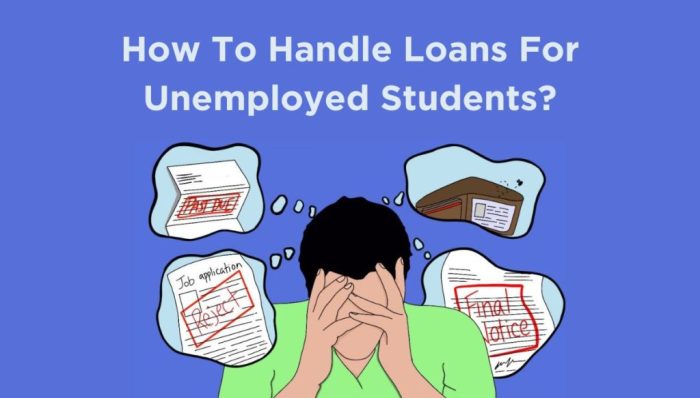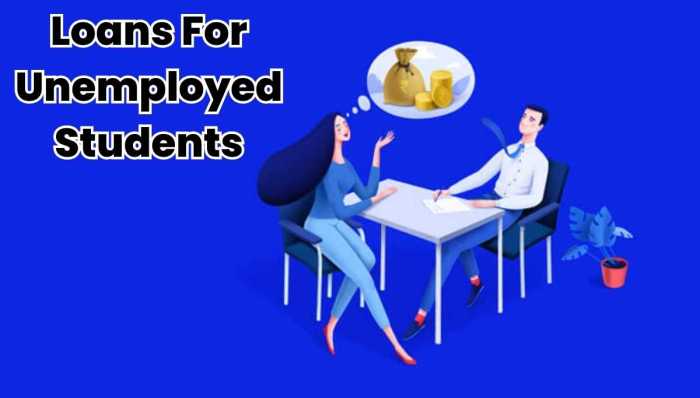
The pursuit of higher education often presents financial challenges, but for unemployed students, the hurdles can feel particularly daunting. Securing funding for tuition, living expenses, and other necessities becomes a complex equation, demanding careful consideration of various loan options and financial strategies. This guide explores the landscape of loans available to unemployed students, offering insights into eligibility criteria, government assistance programs, and responsible debt management techniques.
Understanding the nuances of loan applications, interest rates, and repayment plans is crucial for unemployed students seeking financial support. This resource aims to demystify the process, empowering individuals to make informed decisions and navigate the complexities of securing financial aid while addressing the unique challenges of unemployment.
Types of Loans Available

Securing financial aid as an unemployed student can be challenging, but several loan options exist to help cover educational expenses. Understanding the different types of loans, their eligibility criteria, interest rates, and repayment terms is crucial for making informed decisions. The availability and specifics of these loans can vary depending on your location and the lending institution.
Loan Options for Unemployed Students
Finding suitable financial assistance for unemployed students often involves exploring options beyond traditional student loans. These alternatives may have different eligibility requirements and terms.
| Loan Type | Eligibility Requirements | Interest Rate Range | Repayment Period |
|---|---|---|---|
| Federal Student Loans (e.g., Direct Subsidized/Unsubsidized Loans) | U.S. citizenship or eligible non-citizen status; enrollment at least half-time in an eligible program; demonstration of financial need (for subsidized loans); maintaining satisfactory academic progress. Credit history is not a primary factor. | Varies depending on loan type and year; check the current Federal Student Aid website for precise rates. | Typically begins six months after graduation or dropping below half-time enrollment. Various repayment plans are available. |
| Private Student Loans | Generally requires a creditworthy co-signer (parent or other responsible adult with good credit) due to the lack of credit history of the student. Some lenders may offer loans without a co-signer but with higher interest rates. Enrollment at an eligible institution is usually required. | Highly variable, depending on the lender, creditworthiness of the borrower/co-signer, and market conditions. Rates can be significantly higher than federal loans. | Varies widely depending on the lender and loan terms. Repayment typically begins shortly after disbursement of the loan. |
| Parent PLUS Loans (for parents of dependent students) | U.S. citizenship or eligible non-citizen status; acceptable credit history; enrollment of a dependent student in an eligible program. | Varies depending on the loan year; check the current Federal Student Aid website for precise rates. Generally higher than student loans. | Repayment typically begins within 60 days of disbursement. |
| Income Share Agreements (ISAs) | Eligibility criteria vary significantly by provider; often involves demonstrating potential for future income. | Instead of a fixed interest rate, ISAs typically involve a percentage of future income paid over a set period. The total repayment amount can vary greatly depending on income. | Typically spans several years post-graduation and is tied to income level. |
Interest Rate and Repayment Term Comparisons
Federal student loans generally offer lower interest rates and more flexible repayment options compared to private loans. However, eligibility for federal loans often depends on financial need and maintaining satisfactory academic progress. Private loans, while potentially having higher interest rates, may be more accessible to students who don’t qualify for federal aid or require larger loan amounts. ISAs offer a different approach, where repayment is tied to future income, potentially reducing the financial burden in the short term but potentially leading to higher overall payments if income surpasses expectations. Careful consideration of the total cost of borrowing, including interest and fees, is essential regardless of the loan type chosen.
Eligibility Criteria and Requirements

Securing a loan as an unemployed student presents unique challenges, requiring a thorough understanding of lender requirements. Eligibility hinges on several factors, not all of which are immediately obvious. While lenders understand the circumstances of unemployment, they still need assurance of repayment ability.
Successfully navigating the loan application process requires a clear understanding of the criteria and a proactive approach to addressing potential hurdles. Lenders assess applicants based on a range of factors, balancing the applicant’s circumstances with the lender’s risk tolerance.
Credit History and Co-signers
A strong credit history significantly improves loan approval chances. A positive credit history demonstrates responsible financial management, reassuring lenders of your ability to repay borrowed funds. However, many unemployed students lack an extensive credit history. In such cases, a co-signer – a trusted individual with a good credit score who agrees to repay the loan if you default – can greatly increase the likelihood of approval. The co-signer essentially acts as a guarantor, mitigating the lender’s risk. The co-signer’s credit score and income are carefully scrutinized during the application process. For example, a parent or guardian with a stable income and a high credit score would be an ideal co-signer. Without a co-signer and a limited credit history, loan approval is far less likely.
Challenges Faced by Unemployed Students
Unemployed students often face significant obstacles in meeting loan eligibility criteria. The lack of a steady income stream is a primary concern for lenders. This makes demonstrating repayment capacity difficult, as lenders typically assess affordability based on a consistent income source. Furthermore, a limited or nonexistent credit history further complicates the application process. Building a credit history takes time, and unemployed students may not have had the opportunity to establish a strong credit profile. This lack of credit history can lead to higher interest rates or loan denials. Finally, the absence of significant assets can also hinder loan approval, as lenders may require collateral or other forms of security to mitigate their risk.
Required Documentation
Preparing the necessary documentation is crucial for a smooth application process. A complete and accurate application significantly increases your chances of approval. Incomplete applications often result in delays or rejections.
- Completed loan application form
- Proof of identity (e.g., passport, driver’s license)
- Proof of enrollment in an educational institution
- Proof of address (e.g., utility bill, bank statement)
- Bank statements demonstrating financial history (even if limited)
- If applicable, co-signer’s credit report and income verification
- Details regarding the intended use of the loan funds
Government Assistance Programs
Securing financial aid as an unemployed student can feel daunting, but several government assistance programs are designed to help. These programs offer various forms of support, from grants that don’t need to be repaid to loans with favorable repayment terms. Understanding the nuances of each program is crucial for making informed decisions about your financial future. This section will Artikel key government-sponsored programs and their application processes, highlighting their advantages and disadvantages.
Government assistance programs for unemployed students often vary depending on the country and specific circumstances. However, many share common characteristics, such as income-based eligibility requirements and a focus on supporting students pursuing education or training that leads to employment. It’s vital to research programs specific to your location and situation.
Federal Student Aid Programs (Example: USA)
The U.S. Department of Education administers several federal student aid programs, many of which can be accessed by unemployed students. These programs typically require completing the Free Application for Federal Student Aid (FAFSA) form. The FAFSA assesses your financial need and determines your eligibility for grants, loans, and work-study opportunities. While employment status is not explicitly a disqualifying factor, your income (or lack thereof) will heavily influence the type and amount of aid you receive.
Several key programs under the Federal Student Aid umbrella include:
- Federal Pell Grant: This grant is awarded based on financial need and does not need to be repaid. Unemployed students with low incomes are often eligible for this grant, providing crucial support for tuition and fees.
- Federal Direct Subsidized Loans: These loans are also need-based, and the government pays the interest while you’re in school and during certain grace periods. This can be particularly helpful for unemployed students who lack alternative income sources.
- Federal Direct Unsubsidized Loans: These loans are available regardless of financial need. However, interest accrues from the time the loan is disbursed, making them potentially more expensive than subsidized loans for unemployed students.
The application process involves completing the FAFSA form online, providing accurate financial information, and submitting the completed form to the designated agency. The processing time can vary, so applying well in advance of the academic term is recommended.
State and Local Assistance Programs
Many states and local governments offer additional financial aid programs to supplement federal funding. These programs often have specific eligibility requirements and may focus on particular fields of study or target specific demographics, including unemployed individuals.
Examples of these programs could include:
- State grants: Many states offer need-based grants for higher education, similar to the Federal Pell Grant. The application process and eligibility criteria will vary by state.
- Tuition waivers or reductions: Some institutions may offer tuition waivers or reductions to unemployed students, often in conjunction with state or local programs.
- Scholarships: While not strictly government programs, many scholarships are available through state and local organizations, often targeting specific groups or academic interests. These scholarships can be particularly valuable for unemployed students.
To identify these programs, research the websites of your state’s higher education authority and your local government agencies. Eligibility requirements and application processes vary significantly, so thorough investigation is crucial.
Comparing Government Assistance Options
The benefits and drawbacks of different government assistance options hinge primarily on the repayment terms, interest rates, and eligibility requirements. Grants, like the Pell Grant, are highly beneficial as they don’t need repayment. However, their availability is limited based on financial need and the funding allocated. Loans, on the other hand, provide broader access but necessitate repayment with interest, potentially adding significant costs over time. Subsidized loans offer a degree of protection by covering interest during certain periods, making them more advantageous than unsubsidized loans for unemployed students.
Careful consideration of your financial situation, long-term goals, and the specific terms of each program is essential to make an informed choice.
Final Wrap-Up

Successfully navigating the path to higher education while unemployed requires proactive planning, thorough research, and a realistic understanding of personal finances. By exploring the various loan options, government assistance programs, and alternative funding sources, unemployed students can create a sustainable financial plan that supports their academic pursuits without overwhelming debt. Remember that seeking professional financial advice is a valuable step in ensuring long-term financial well-being.
User Queries
What if I have a poor credit history?
A poor credit history can make securing a loan more difficult. Consider exploring loans with co-signers or seeking government-backed loans which may have more lenient credit requirements.
Are there any loan forgiveness programs for unemployed students?
Some government loan programs may offer income-driven repayment plans or forgiveness options based on specific criteria, such as public service employment. Research the terms of individual programs carefully.
How can I find a financial advisor specializing in student loans?
Contact your university’s financial aid office or search online for certified financial planners or student loan counselors. Many non-profit organizations also offer free or low-cost financial counseling services.
What happens if I default on my student loan?
Defaulting on a student loan can have serious consequences, including damage to your credit score, wage garnishment, and potential legal action. Contact your lender immediately if you anticipate difficulties in making payments to explore repayment options.
